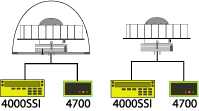UNAVCO testing of the SCIGN radome (2001)
SCIGN Dome Testing
The purpose of this test was to see the affects on station coordinates when a SCIGN radome is placed on a choke ring antenna. This report presents results from a test that was conducted at the UNAVCO facility in Boulder Colorado.
Experiment Description for UNAVCO’s test of SCIGN Radome
Data was collected for 5 days, 24 hours a day. Two sets of receivers were run concurrently. See Figure 1 below. Each pair of receivers were run through a single splitter that was connected to a Trimble choke ring antenna (defined by the IGS to be TRM29659.00). Each set of receivers were run in a similar zero baseline configuration.

Processing Strategies
All data were quality checked and edited using teqc, and processed using the Bernese GPS Software version 4.2. The data were processed as 24 hour files. Results from each of the following strategies will be looked at:
For 5 deg, 10 deg, and 15 deg elevation cutoff
L1 Phase Resolve Ambiguities
L1 Phase Resolve Ambiguities + Trop
L2 Phase Resolve Ambiguities
L2 Phase Resolve Ambiguities + Trop
L3 Phase Use L1 and L2
L3 Phase Use L1 and L2 + Trop
Results for this test
The results of UNAVCO’s SCIGN dome testing indicate sub-centimeter offsets, with a largest vertical offset of 5.65 mm +/- 1.21 mm for the Trimble 4000 SSI receiver pair at a 15 degree elevation cutoff. The largest North offset observed was 1.45 mm +/- 0.52 mm in L3 with troposphere parameters estimated and a 5 degree elevation angle cutoff for the Trimble 4000 SSI receiver pair. The largest East offset observed was 1.24 mm +/- 0.33 mm in L3 with troposphere parameters estimated, for the Trimble 4700 receiver pair at a 5 degree elevation angle cutoff. After presentation of preliminary results to certain members of the UNAVCO community, it was determined that future work needs to take place in this area. Future work includes re-processing the data with some of the following parameters: fixed reference station ~ 300 km away using the double difference baseline strategy with the L3 (LC) observable, ambiguity resolution using the "QIF" strategy, zenith troposhperic delay: - stochastic, hourly, and piecewise constant, no apriori troposphere model, "Dry Niell" troposphere mapping function, and solid earth tide models. Along with other parameters not mentioned here.
Report (draft):
UNAVCO Facility SCIGN Dome Testing Report (.pdf)
Useful Links
SCIGN Web page with various information regarding testing of SCIGN Radomes.
SCIGN Dome
The following link will take you to the ISGPS Icelandic Continuous GPS Network report ISGPS Report
The following link will take you to the Short Baseline tests of SCIGN radomes reported by Ken Hudnut SCIGN Radomes
Send questions or comments about this page to Support (support![]() unavco.org).
unavco.org).
)